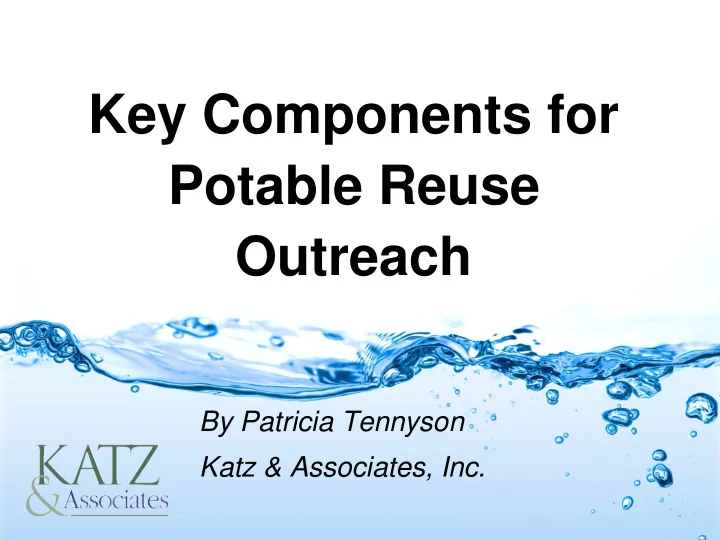

Key Components for Potable Reuse Outreach By Patricia Tennyson Katz & Associates, Inc.
Today’s Agenda Importance of consistent, sustained outreach Challenges for water reuse Suggestions for engaging the public Recent research What’s worked well for some utilities A few “lessons learned”
Three Key Guidelines Define purpose/need Identify range of community interests, understand concerns and issues Outreach must be consistent and sustained or project will be forgotten
Consistency Counts Orange County’s GWRS is a model – Leadership at board and staff level – Research-based messages – Effective multi-cultural outreach – Frequent briefings: policy makers/media – Comprehensive, sustained outreach program “We talked to anyone who would listen to us!”
Opposition Happens Opposition CAN’T be totally controlled Opposition CAN develop at any time Opposition may not be able to be neutralized You need a good “insurance policy” – an effective outreach program.
Water Reuse Challenges Does the science work here? The water itself, how we talk about it Safety and health concerns, unknowns Trust
Potable Reuse Challenges Environmental “Toilet to Tap” CECs, Unknown Justice Contaminants Political Cycles Competing Water Supplies
The What and the Why Clearly state purpose/need Address potential time bombs Show value to community Emphasize the “urban water cycle”
Tell and Show Explain in clear, easy-to-understand, and commonly accepted terminology Gain support from community leaders, legislators and regulators – and water industry Provide tours: discuss process, unknowns and purity of the water
Public Engagement Produce informational materials – Easy to understand – Print and electronic format – Appropriate for all ages Work with policy makers, stakeholders, interest groups Reach out to schools, seniors, multi- cultural leaders and more
Monitoring Program When people run out of other objections, they ask: What about human error?” Establish and maintain a robust monitoring program
Recent Research Findings GWRS tour surveys – Safe to drink advanced purified/recycled wastewater? • Safe pre-tour 80.8%; Post-tour 96.5% – Support for advanced purified/recycled wastewater as 100% of drinking water supply (direct to your tap and/or bottled)? • Post-tour only: 90% strongly support/support
Recent Research Findings WRF 09-01– Downstream: Context, Understanding, Acceptance* (Focus Group findings) – Water knowledge important – Finished quality of water more important than history – Direct reuse scenario preferred as safest *CH2M Hill
WRRF 13-02: Model Public Communication Plans Literature review In-depth interviews Focus groups/public opinion surveys State level communication plan Local communication plan
WRRF 13-02: Research Findings Majority support IPR (62%) Initially most oppose DPR – but support goes to 56% with information about safety Treatment steps alone build support Testing/monitoring influence support Environmental message next most effective
What’s Worked Well Plant tours Direct face-to-face contact Working closely with community leaders Community-based advisory group Keeping regulators informed Establish relationships with media and engage them early
What’s Worked Well, cont’d School/youth outreach Frequent notices of water supply levels Speakers’ bureau Getting support commitment in writing Website, videos, radio interviews, social media
Impediments to Acceptance Safety/health/quality concerns Engaging busy public, leaders, elected officials Making complex issues understandable: terminology, lay language, messages Media sensationalism
Lessons Learned Ensure water agency is project lead Emphasize importance/need for all local water supply sources Correct inaccuracies immediately Conduct repeated policy maker briefings Identify/work with strong third-party allies
More Lessons Emphasize the water cycle! Terminology matters Know your community Tours/tasting opportunities Media outreach/social media “Go to them” vs. “Come to us”
Summary Develop a strategic outreach plan Remember that policy makers are a key audience Look for all outreach opportunities Make sure outreach is consistent and sustained Get out of the office and into the community
Key Components for Potable Reuse Outreach By Patricia Tennyson Katz & Associates, Inc. ptennyson@katzandassociates.com
Recommend
More recommend